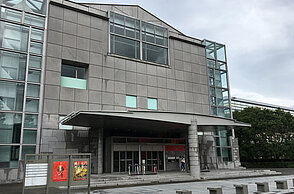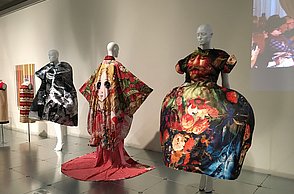Prof. Tamotsu Kondo at Kyoto University of Art and Design, Kyoto, Japan
I flew to Kyoto this August because I was invited to teach at the Kyoto University of Art and Design. Every year I travel to Kyoto at the same time of the year. This year it wasn't as hot as last summer but it was still very humid and exhausting to go outside because of the typhoon. In Europe it just doesn't get as humid and accordingly you don't sweat as uncomfortably. This gives rise to a special feature of the Asian fashion markets such as Japan - the strong demand for highly functional summer clothing.
Kyoto is the old capital of Japan and home to several art universities. The Kyoto University of Art and Design has over 3000 students, which is an impressive number for a university without a music faculty. In this university, the fashion department is under the main faculty of spatial design and such, regards fashion as part of spatial design.
The event of Nebuta Matsuri at this university is well known throughout Japan and during my seminar many students were busy building Nebuta floats.
Every summer I teach students in the 2nd academic year, the equivalent of students in the 3rd semester. This visit was already my 15th year. In the last years I have worked, just like in Pforzheim, with the starting point of a "color" and have yearly observed the differences between Japan and Germany in the understanding of the task and in the conception of colors as such.
The theme of this year was "Blue", the same as in the 1st semester of the summer semester in Pforzheim. In Pforzheim we work on the project for a whole semester, discuss it, dye and process the fabrics by hand and work our way up to the outfits. We repeat the design process and have time to get close to an end product that really fits the theme.
In Kyoto we only have 5 working days. Within this short period of time, it is not easy to discover the depth of the influence colors have on our lives and to address important issues. What these students lack in time needed to go into deep ideas or stories, the students often make up for by expressing themselves close to reality and life.
The tendency in Germany was that the students were guided by the blue color in the direction of environmental policy. Conversely, the young students in Japan were more concerned with expressing the personal, psychological difficulties and contradictions they associated with blue. Many German students see the fashion industry as one of the biggest causes of environmental pollution or fashion as a tool to solve the big problems. Many Japanese students see fashion as a means of communication to reveal their inner problems, complaints and complexes to the outside world.
Among the Japanese students, there was also one who suffered from self-harm and incorporated her wrist cuts into her design. She felt closed up in her parents' ideals of her and wanted a tattoo of wings to completely cover her back as a symbol of her freedom. For her, this dark blue color represented her traumas and complexes. There was also a student who was aware of his less severe multiple personality disorder, and who saw in this color an escape into the world of fairytales (The Little Prince).
In addition to suicide, the so-called "hikikomori" (retreat/seclusion) is one of the major social problems among young people in Japan, whereby these people lose touch with the outside world and no longer dare to leave their homes. These individuals maintain virtual contact with the environment through the Internet and online games. One could perhaps say that for these individuals, fashion is also an outward communication method.
Another representative facet of the Japanese subculture is the impact of the Peter Pan syndrome - in which the person affected cannot separate from the impressions of childhood and lives in memories. There are many female students in particular who cannot grow out of being a girl, or who cannot even imagine growing older. Every year I see some works by female students who cannot step out of the princess look.
Of course, there were also students who perceived blue as an approach to environmental discussion, but were outnumbered by those who see fashion as a mirror for them and as a means of expression of the interior, especially in comparison to Germany. It is not my job to judge which approach is superior. Nevertheless, the experience in Kyoto gave me food for thought and my conclusion was that today's Japanese designers, who attract attention and represent the Japanese subculture through mangas and cosplay, are very strongly based on the expression of their own needs.
On my return flight to Germany I saw on the Lufthansa plane "The amazing life of Walter Mitty". This film is about a dreamy male employee at Life-Magazine, which saw its end in the course of digitalization in 2012. This protagonist is a daydreamer and often fails to communicate with other people. One day, however, he hears the woman he's secretly in love with singing David Bowie's "Space Odyssey" and is encouraged to venture into the world. This film positively surprised me.
It is, of course, important to address contemporary issues such as environmental degradation through fashion. But as I watched the film, a part of me thought, that dealing with our depth psychology and our dark sides through fashion could address issues of the future. As I looked down at the clouds from the plane, I pondered whether this might be why we can be so deeply touched by a collection by Alexander McQueen or Comme des Garçons.













